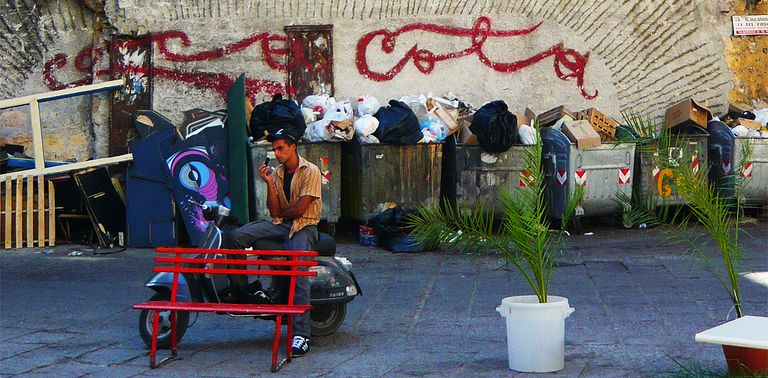A Gentle Griffin
The Jakarta Post, 2 Dec 2007.
A Gentle Griffin
http://www.thejakartapost.com/yesterdaydetail.asp?fileid=20071202.L20
Curiously the locals -- often for simplicity's sake -- describe their town's whereabouts as "between Rome and Florence".
But it's not in a geographically or culturally linear way, because Perugia, the first city of Umbria, merits a deviation or even a long term sojourn.
The hilly region of Umbria now consistently draws visitors in search of something more sui generis, in the green heart of Italy, than its more well-known big sister, Tuscany.
Perugia, in contrast to Florence's air of renaissance, feels and looks extraordinarily medieval.
Until this very day, Augusta Perusia, the ancient Imperial Roman town with a roaring Griffin on its coat of arms, still boasts an array of medieval structures, largely dating back to the 12th and 13th century.
Make no mistake, there's more to this town than meets the eye, Perugia was (and, in many ways, still is) Etruscan before the Roman conquest in 295 B.C.
It may be a small provincial town, yet Perugia prides itself as one of Italy's best-preserved medieval burgs.
And because an Etruscan town layout differs to the regular Roman grid pattern, a circular stroll starting from the Duomo (the cathedral of San Lorenzo) will usurp you into a journey through the town's history and golden age.
A pre-Christ pagan temple, a jumble of criss-crossed sky-high arches hovering over a labyrinth of narrow and dark passageways, superb civic palaces in a harmonious 12th century fa‡ade (a testimony to Perugia's affluent mercantile class), and a 16th century apartment strategically perched on the world's mightiest Etruscan stone structure (the two millennia old Arco Etrusco at the end of via Ulisse Rocchi is real eye-opener).
Enough arch-watching? Then it may be time for some serious ceramic making. By tradition, the Umbrian region is reputed for its top-notch ceramics, a cultural legacy of the mysterious Etruscan tribe. Visitors can take up ceramic classes offered on a casual basis in the nearby vicinity of Perugia, the town of Deruta, Umbria's ceramic production center.
If this does not tickle your fancy, perhaps a day trip to Torgiano will help you become a connoisseur of Italian wine.
Head for Torgiano, the province's cantina (cellar). It boasts a limitless view of vineyards cultivated over the last 20 centuries and offers some serious wine tasting sessions.
Alternatively, in this quaint village 16 kilometers east from Perugia, travelers can visit the Museo del Vino (the Wine Museum).
And for the art buffs, there's no shortage of Renaissance art delights. Perugia's own golden boy Pinturicchio and Pietro Vannucci (also known as the Perugino) are synonymous with pioneering the early Renaissance techniques -- the latter was master to the young Raphael Santi in his workshop.
Head toward the chapel of San Severo to adore suggestive Raffael and Perugino's frescoes.
Traditionally, an Italian town's zero kilometer refers to the highest point, and in Perugia this corresponds to Porta Sole, a chic quarter that sits at 293 metres above sea level.
But for many, Perugia's center is analogous with its fountain. Constructed between 1275 and 1278, the Fontana Maggiore, a two-tiered marble water feature masterpiece depicting 12 zodiacal signs and feudal agrarian folkloric scenes, proves to be a such prominent medieval sculpture, it is repeatedly considered one of Italy's most important and splendid public fountains.
The fact the campanilismo -- one's attachment to his regional customs traditions -- may well still be alive in Umbria seems to work well with Perugia's cosmopolitan atmosphere, boosted largely by its student population.
Obviously, a multitude of academic residents have helped the town's rejuvenation process in their haunting of the University of Perugia in the last nearly 800 years after its foundation year of 1308 (making it Italy's third oldest university).
Whereas the younger one, The University for Foreigners, commenced giving Italian language and culture courses in 1928 at its imposing 17th century Gallenga palace in piazza Fortebraccio, and houses roughly 5,000 students at any one time.
So when the belfry hits 12 times at midnight, understandably the pedestrian-only centro and its many piazzas turn into a busy circus-like social fair, inciting revelers into an euphoric ambience typically Italian.
To stay at Perugia's best spot, Hotel Brufani is the place. This quasi landmark five-star de luxe establishment is renowned for having welcomed the Mother Queen of England and royalties alike.
According to locals, the top level of the luxurious hotel is owned by the Sultan of Brunei, but for whoever stays there, the seductive panorama over Perugia's skyline remains unaltered to each visitor.
No Italian could deny their penchant for their passeggiata, the quintessential Italian evening promenade.
In Perugia, the locals even have a local term: fare la vasca, which means "doing the tub", a convention to suavely roam the corso Vannucci, the number one avenue in Perugia's center dotted with Italian designer's boutiques.
Locals expect to encounter friends for a good round of chit-chat upon their sacrosanct passeggiata ritual.
And clearly, no trip in Italy is complete without having sampled its notoriously delicious gelato.
Real Italian gelati (the plural of gelato) must be produced fresh the same day -- more importantly, in an artisanal way -- to ensure unrivaled tastes unattainable outside the belpaese, Italy.
In Perugia, locals recommend the Veneta gelateria in Piazza Italia or the Fontana Maggiore (behind the Palazzo dei Priori) for some luxuriously melt-in-your-mouth gelato.
Two international events occur twice every year. The month of July sees elite jazz musicians swamp the Etruscan acropolis to spark the annual Umbria Jazz. Household names including Eric Clapton, Sting and Elton John have been invited in the past.
Your chance to walk through different stalls and exhibitions of all things chocolaty shall be this year's Eurochocolate in October; the occasion is said to be Europe's largest congregation of chocolate producers, just perfect to get intimate with Perugina's iconic Baci love messages and rare artisanal chocolate bars and liqueurs. Too delicious to miss.

0 comments:
Posta un commento